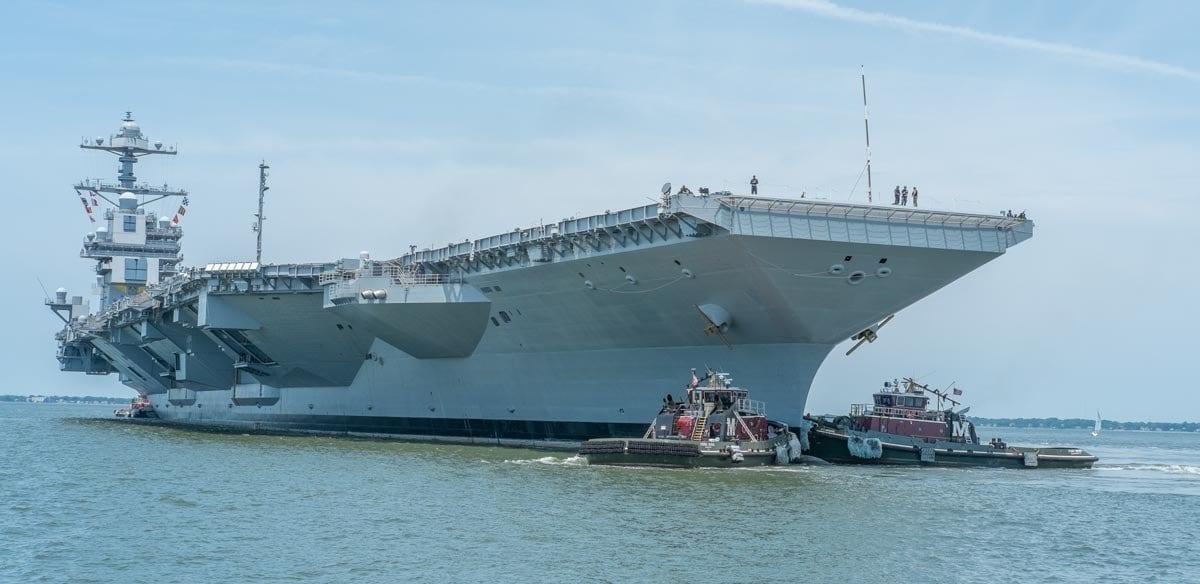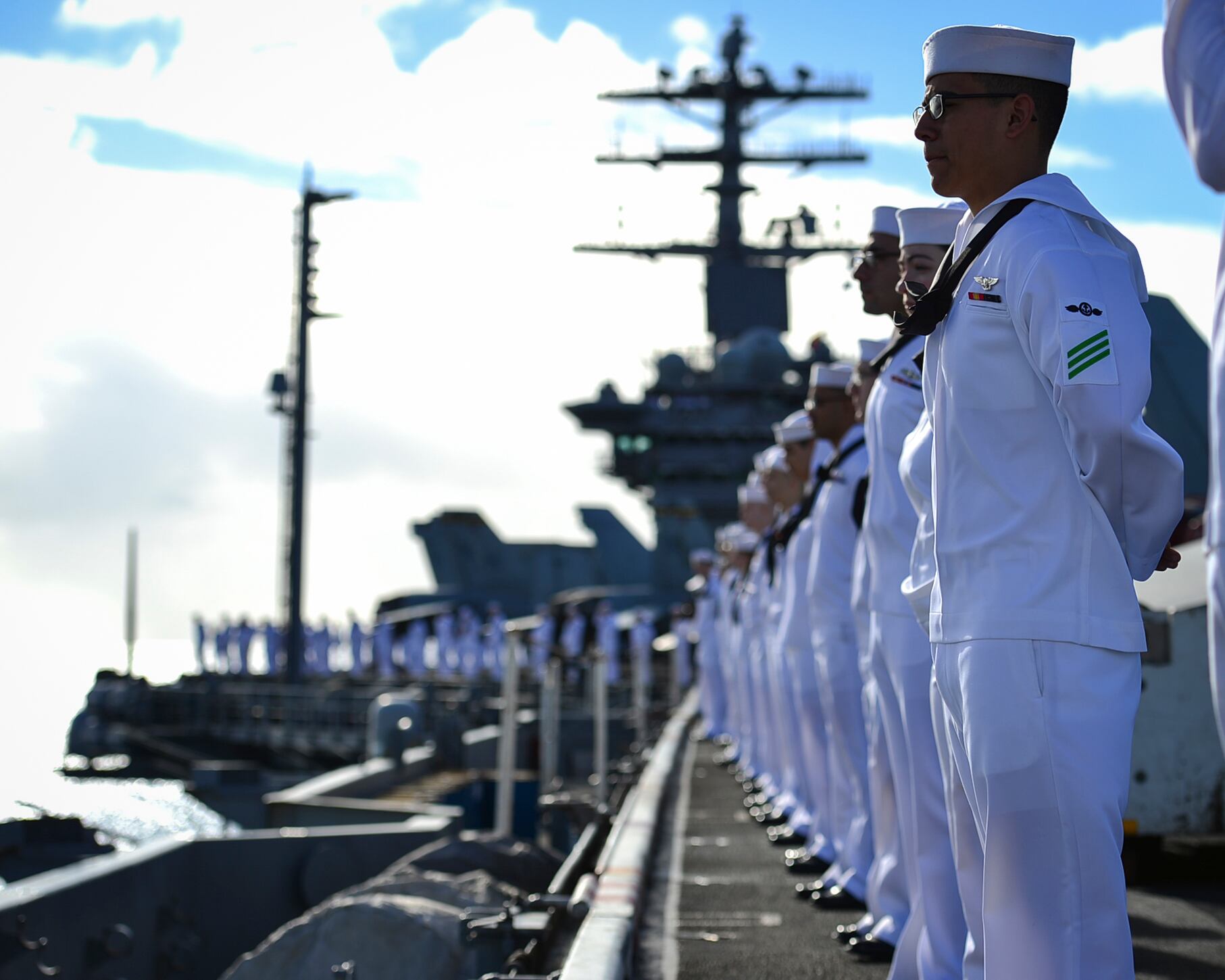The aircraft carrier Abraham Lincoln must stay overseas while its replacement, the carrier Harry S. Truman, is down for maintenance, and flattop Gerald R. Ford is delayed, but the Navy’s fixing its readiness woes, Vice Chief of Naval Operations Adm. Bob Burke reported Friday.
Speaking at the annual Military Reporters and Editors conference at Navy League headquarters in Arlington, Virginia, he said the sea service has a “healthier surge force” of carriers and aircraft than it could summon only two years ago, with better training for the crews and more supplies and equipment to outfit the fleet.
Ordered by the Pentagon to shore up years of shoddy maintenance of its F-18 E/F Super Hornet and EA-18G Growler squadrons, Burke said the Navy hurdled the mandated 80 percent readiness rate and now is trying to sustain the gains.
Aided by commercial airline experts and ongoing efforts to modernize the Navy’s supply chain, Burke said the Navy “changed its process” and began rethinking how the sea service invests in new technologies, such as hypersonic weapons, long-range missiles, drones, lasers and “plug and play” technology for warships.
RELATED

The state of the first-in-its-class flattop Ford sparked a war of words between U.S. lawmakers and Navy leaders this week, but Burke insisted Friday that shipyard crews and sailors have made “significant strides" to fix the “game changer” technology on the “incredibly complex” carrier.
He pointed out that it’s the first new carrier design in four decades but its crew would soon start the process of certifying its systems and getting it prepped to deploy overseas.
And it’s not as if there aren’t problems with the older fleet of Nimitz-class carriers. Five of those Norfolk-based flattops can’t be deployed now because they’re undergoing maintenance, although Burke announced Truman’s reported electrical glitches would be repaired in “weeks, not months."
He took a longer view of the readiness crunch, looking back two decades to operational schedules and budgets erected after the fall of the Berlin Wall in 1989. When U.S. forces went to war in 2001 in Afghanistan and later Iraq and other global hot spots, carrier aircraft performed many of the strike missions providing air support for the grunts on the ground.
Those missions wore out the jets and the carriers that brought them to battle, Burke said.
When lawmakers on Capitol Hill passed the Budget Control Act of 2011, they reduced the federal budget deficit but triggered so-called “sequestration” cuts that trimmed defense spending, including funds needed to mend and man carrier strike groups.
Continuing resolutions from Congress didn’t help, but an influx of funds beginning in 2017 began to help right the Navy fleet.
Going forward, Burke said that military planners with the combatant commands might need to take an “appetite suppressant” when they hunger for more carriers and submarines in their corner of the globe. He said that both lawmakers and commanders have come to realize that the Navy’s current topline budget — if sustained at present levels — can support a Navy with 305 to 310 warships, not the 355-ship fleet once targeted by Congress and the Pentagon.
The focus now is on capabilities, what a fully-manned and supplied force can bring to a sea battle. It likely will be aided by new technology, including unmanned underwater vehicles that hunt for enemy mines and MQ-25 robot refuelers that promise to free Super Hornet strike fighters from their aerial gas station duties.
They’ll need all the help they can get from other services and federal agencies, overseas allies and private industry’s technological innovations because America’s potential enemies are catching up to the Navy, Burke warned.
Burke said he felt a “sense of urgency" based on his view that U.S. adversaries “have made up a lot of ground and are right behind us in the rear view mirror and in a lot of ways, many ways, they might be ahead of us.”
RELATED

But Burke isn’t worried about the foundation of America’s naval power: the sailor.
The former chief of naval personnel before becoming the Navy’s 40th vice chief of naval operations on June 10, Burke spearheaded crucial reforms to the way the modern sea service recruits, trains and retains its labor force.
His Sailor 2025 initiatives revamped a personnel system that hadn’t been changed in some areas since the 1850s. Those innovations included 24/7 call centers to help frustrated service members and their families cut through red tape and new programs to advance sailors faster in their careers.
The typical recruit today is older than in past generations — 21 ½ years old — and they’re reenlisting in record numbers. Last year, three out of every four first-tour sailors re-upped.
That’s double the historical average and occurred during a hot economy and increasing competition from the private sector and the other armed forces for their services, Burke said.
It’s still tough to fill billets for cryptologists and nuclear-trained sailors, but “surgical” incentive payments to keep qualified sailors and other perks have helped, he added.
But in the long run, Burke said, recruiting will be a challenge.
“We’re very concerned about the sustainability of a pool that’s just getting smaller and smaller,” said Burke.




